Boeing 707 Videos
|
Loading...
|
|
Boeing 707
Boeing 707 / 720
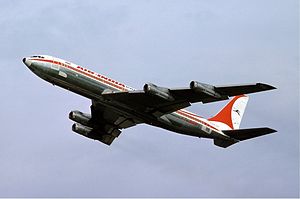
Picture - Air India 707-320B takeoff at Basel, Switzerland in 1976.
Role: Narrow-body jet airliner
National origin: United States
Manufacturer: Boeing Airplane Company
First flight: December 20, 1957
Introduction: October 1958 with Pan American
Status: Out of production, in limited use
Primary users: Trans World Airlines
Eastern Air Lines
Pan Am
BOAC
Produced: 1958-1979
Number built: 1,010
Unit cost: US$4.3 million (1955 dollars)
Developed from: Boeing 367-80
Variants: Boeing C-137 Stratoliner
Boeing E-3 Sentry
Boeing E-6 Mercury
E-8 Joint STARS
The Boeing 707 is a four-engine narrow-body commercial passenger jet airliner developed by Boeing in the early 1950s. Its name is most commonly pronounced as "Seven Oh Seven". The first airline to operate the 707 was Pan American World Airways, inaugurating the type's first commercial flight on October 26, 1958. Boeing delivered a total of 1,011 Boeing 707s including a smaller, faster model of the aircraft that was marketed as the Boeing 720.
Although it was not the first commercial jet in service, the 707 was among the first to be commercially successful. Dominating passenger air transport in the 1960s, and remaining common throughout the 1970s, the 707 is generally credited with ushering in the Jet Age. It established Boeing as one of the largest makers of passenger aircraft, and led to the later series of aircraft with "7x7" designations.
Development
Model 367-80 origins
Boeing, during and immediately after World War II, was known for its military aircraft. The company had produced innovative and important bombers, from the B-17 Flying Fortress and B-29 Superfortress, to the jet-powered B-47 Stratojet and B-52 Stratofortress. The company's civil aviation department lagged far behind Douglas and other competitors, the only noteworthy airliners being the Boeing 314 Clipper and 307 Stratoliner. During 1949-1950, Boeing embarked on serious studies for a new jet transports, realizing that any design must have the potential to fulfill both the military and civil markets. At the time, aerial refueling was increasingly becoming a standard operational technique, with over 800 KC-97 Stratotankers being on order. With the advent of the jet age, a new tanker was required to meets the USAF's fleet of jet-powered bombers; this was where Boeing's new design would potentially win military orders.
Boeing studied a numerous wing and engine configurations for its new transport/tanker, some of which were based on the B-47 and C-97, before settling on Model 367-80. The "Dash 80" took less than two years from project launch in 1952 to rollout on May 14, 1954, then first flew on July 15, 1954. It was powered by the Pratt & Whitney JT3C turbojet engine, which was the civilian version of the J57 used on many military aircraft of the day, including the F-100 fighter and the B-52 bomber.
The prototype was conceived as a proof of concept aircraft for both military and civilian use: the United States Air Force was the first customer for the design, using it as the KC-135 Stratotanker midair refueling platform. It was far from certain that the passenger 707 would be profitable. At the time, Boeing was making nearly all of its money from military contracts: its last passenger transport, the Boeing 377 Stratocruiser, had netted the company a $15 million loss before it was purchased by the Air Force as the KC-97 Stratotanker.
The 132-inch (3,350 mm) fuselage of the Dash 80 was only wide enough to fit two-plus-two seating (in the manner of the Stratocruiser). Answering customers demands and under Douglas competition, Boeing soon realized that this would not provide a viable payload, so decided to widen the fuselage to 144 in (3,660 mm), the same as the KC-135 Stratotanker, which would allow six-abreast seating - and the shared use of the KC-135's tooling. However, Douglas Aircraft had launched its DC-8 with a fuselage width of 147 in (3,730 mm). The airlines liked the extra space, and so Boeing was obliged to increase the 707's cabin width again, this time to 148 in (3,760 mm). This meant that little of the tooling that was made for the Dash 80 was usable for the 707. The extra cost meant the 707 did not become profitable until some years after it would have if these modifications had not been necessary.
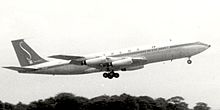
Picture - Early production Boeing 707-329 of Sabena in April 1960 retaining the original short tail-fin and no ventral fin
Production and testing
The first flight of the first production 707-120 took place on December 20, 1957, and FAA certification followed on September 18, 1958. A number of changes were incorporated into the production models from the prototype. A Krueger flap was installed along the leading edge between the inner and outer engines on early 707-120 and -320 models.
Further developments
The initial standard model was the 707-120 with JT3C turbojet engines. Qantas ordered a shorter body version called the 707-138, which was a -120 that had six fuselage frames removed, three in front of the wings, three aft. The frames in the 707 were each 20 inches (500 mm) long, so this resulted in a net shortening of 10 ft (3 m) to 134 ft (41 m), 6 inches (41 m). Because the maximum takeoff weight remained the same 247,000 lbs (112 Tonne) as the -120, the 138 was able to fly the longer routes that Qantas needed. Braniff International Airways ordered the higher-thrust version with Pratt & Whitney JT4A engines, the 707-220. The final major derivative was the 707-320 which featured an extended-span wing and JT4A engines, while the 707-420 was the same as the -320 but with Rolls-Royce Conway turbofan engines. British certification requirements relating to engine-out go-arounds also forced Boeing to increase the height of the tail fin on all 707 variants, as well as add a ventral fin, which was retrofitted on earlier -120 and -220 aircraft. These modifications also aided in the mitigation of dutch roll by providing more yaw stability.
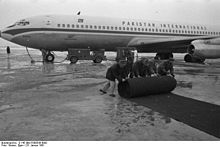
Picture - A Pakistan International Airlines Boeing 707 photographed in Germany, 1961
Though initially fitted with turbojet engines, the dominant engine for the Boeing 707 family was the Pratt & Whitney JT3D, a turbofan variant of the JT3C with lower fuel consumption as well as higher thrust. JT3D-engined 707s and 720s were denoted with a "B" suffix. While many 707-120Bs and 720Bs were conversions of existing JT3C-powered machines, 707-320Bs were only available as newly-built aircraft as they had a stronger structure to support a maximum take-off weight increased by 19,000 lb (8,600 kg), along with minor modifications to the wing. The 707-320B series enabled non-stop westbound flights from Europe to the US west coast.
The final 707 variant was the 707-320C, (C for "Convertible") which was fitted with a large fuselage door for cargo applications. This aircraft also had a significantly revised wing featuring three-section leading-edge flaps. This provided an additional improvement to takeoff and landing performance, and also allowed the ventral fin to be removed (although the taller fin was retained). 707-320Bs built after 1963 used the same wing as the -320C and were known as 707-320B Advanced aircraft.
Production of the passenger 707 ended in 1978. In total, 1,010 707s were built for civil use, though many of these found their way to military service. The purpose-built military variants remained in production until 1991.
Traces of the 707 are still found in the 737, which uses a modified version of the 707's fuselage, as well as essentially the same external nose and cockpit configuration as the 707. These were also used on the previous Boeing 727, while the Boeing 757 also used the 707 fuselage cross-section. The Chinese government sponsored development of the Shanghai Y-10 during the 1970s, which was a near carbon-copy of the 707; however, this did not enter production.
Design
Wings
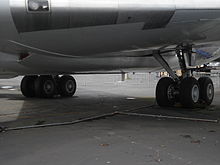
Picture - The 4 wheel landing gear bogies on a 707-120
The 707 wings are swept back at 35 degrees and, like all swept-wing aircraft, displayed an undesirable "Dutch roll" flying characteristic which manifested itself as an alternating yawing and rolling motion. Boeing already had considerable experience with this on the B-47 and B-52, and had developed the yaw damper system on the B-47 that would be applied to later swept wing configurations like the 707. However, many new 707 pilots had no experience with this phenomenon as they were transitioning from straight-wing propeller driven aircraft such as the Douglas DC-7 and Lockheed Constellation.
On one customer acceptance flight, where the yaw damper was turned off to familiarize the new pilots with flying techniques, a trainee pilot's actions violently exacerbated the Dutch Roll motion and caused three of the four engines to be torn from the wings. The plane, a brand new 707-227, N7071, destined for Braniff, crash landed on a river bed north of Seattle at Arlington, Washington, killing four of the eight occupants.
In his autobiography, test pilot Tex Johnston described a Dutch Roll incident he experienced as a passenger on an early commercial 707 flight. As the aircraft's movements did not cease and most of the passengers became ill, he suspected a misrigging of the directional autopilot (yaw damper). He went to the cockpit and found the crew unable to understand and resolve the situation. He introduced himself and relieved the ashen-faced captain who immediately left the cockpit feeling ill. Johnston disconnected the faulting autopilot and manually stabilized the plane "with two slight control movements".
Engines
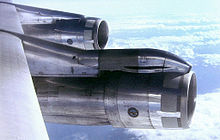
Picture - View of number 1 (top left) and 2 (center) Pratt & Whitney JT3D jet engines on the port side of a British Caledonian Boeing 707-320B. The number 1 engine mount (top) is different from the other three engines.
The 707's used engine-driven turbocompressors to supply high-pressure air for pressurization. The engines could not supply sufficient bleed air for this purpose without a serious loss of thrust. On many commercial 707s the outer port (#1) engine mount is distinctly different from the other three, as this is the only engine not fitted with a turbocompressor. With engines 2 through 4 being fitted with TCs, they provide the triple redundancy required of the aircraft's cabin pressurization and air-conditioning system.
The P&W JT3D-3B engines are readily identifiable by the large gray secondary air inlet doors in the nose cowl. These doors are fully open (sucked in at the rear) during takeoff to provide additional air. When the engines are throttled back to cruise, the doors are shut.
Upgraded engines
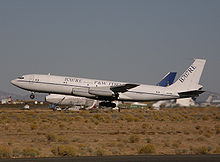
Picture - Omega Air's 707-330C testbed for the 707RE program takes off from the Mojave Airport
Pratt & Whitney, in a joint venture with Seven Q Seven (SQS) and Omega Air, has developed the JT8D-219 as a re-engine powerplant for Boeing 707-based aircraft, calling their modified configuration a 707RE. Northrop Grumman has selected the -219 to re-engine the United States Air Force's fleet of 19 E-8 Joint STARS aircraft, which will allow the J-STARS more time on station due to the engine's greater fuel efficiency. NATO also plans to re-engine their fleet of E-3 Sentry AWACS aircraft. The -219 is publicized as being half the cost of the competing 707 re-engine powerplant, the CFM International CFM56, and is 40 dB quieter than JT3D engines that are being replaced.
Operational history
The first commercial orders for the 707 came on October 13, 1955, when Pan Am committed to 20 707s and 25 Douglas DC-8s, a dramatic increase in passenger capacity over its existing fleet of propeller aircraft. The competition between the 707 and DC-8 was fierce. Several major airlines committed only to the DC-8, as Douglas Aircraft was a more established maker of passenger aircraft at the time. To stay competitive, Boeing made a late and costly decision to redesign and enlarge the 707's wing to help increase range and payload. The new version was numbered 707-320.
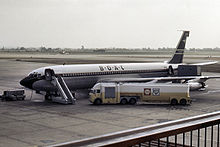
Picture - Conway-powered BOAC 707-436 at London Heathrow Airport in 1964.
Pan Am was the first airline to operate the 707; the aircraft's first commercial flight was from New York to Paris on October 26, 1958 with a fuel stop in Gander, Newfoundland. In December National Airlines operated the first U.S. domestic jet airline flights between New York/Idlewild and Miami, using 707s leased from Pan Am; American Airlines was the first domestic airline to fly its own jets, on January 25, 1959. TWA started domestic 707-131 flights in March and Continental Airlines started 707-124 flights in June; airlines which had only ordered the DC-8, such as United, Delta and Eastern, were left jetless until September and lost market share on transcontinental flights.
The 707 quickly became the most popular jetliner of its time. Its popularity led to rapid developments in airport terminals, runways, airline catering, baggage handling, reservations systems and other air transport infrastructure. The advent of the 707 also led to the upgrading of air traffic control systems to prevent interference with military jet operations.
As the 1960s drew to a close, the exponential growth in air travel led to the 707 being a victim of its own success. The 707 was now too small to handle the increased passenger densities on the routes for which it was designed. Stretching the fuselage was not a viable option because the installation of larger, more powerful engines would in turn need a larger undercarriage, which was not feasible given the design's limited ground clearance. Boeing's answer to the problem was the first twin aisle airliner - the Boeing 747. The 707's first-generation engine technology was also rapidly becoming obsolete in the areas of noise and fuel economy.
In 1982, during the Falklands War the Argentine Air Force extensively used civilian 707s for long-range maritime patrol, with some of them being intercepted and shepherded away by Royal Navy Sea Harriers, it also led to the conversion of British Nimrods to carry Sidewinder air-to-air missiles after a casual encounter.
Trans World Airlines flew the last scheduled 707 flight for passengers by a US carrier on October 30, 1983, although 707s remained in scheduled service by airlines from other nations for much longer. For example Middle East Airlines (MEA) of Lebanon flew 707s and 720s in front-line passenger service until the end of the 1990s. Since LADE of Argentina took its 707-320B from regular service in 2007, Saha Air Lines of Iran is the last airline to keep 707s in scheduled passenger service.
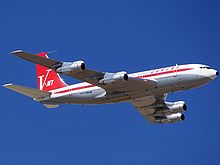
Picture - An ex-Qantas Boeing 707-138B, owned by John Travolta, repainted in vintage Qantas livery
In 1984, a Boeing 720 that was flown by remote control was intentionally crashed at Edwards AFB as a part of the FAA and NASA Controlled Impact Demonstration program. The test provided peak accelerations during a crash.
Operations of the 707 were threatened by the enactment of international noise regulations in 1985. Shannon Engineering of Seattle, Washington developed a hush kit with funding from Tracor, Inc, of Austin, Texas. By the late 1980s, 172 Boeing 707s had been equipped with the Quiet 707 package. Boeing acknowledged that more 707s were in service then than before the hush kit was available. Most remaining 707s are in freighter form, or as Business Jets.
Honeywell operated the last Boeing 720 in operation in the United States, flying out of Sky Harbor airport in Phoenix. The aircraft had been modified with an extra engine nacelle mounted on the right side of the fuselage to allow testing of a turbine engine at altitude, operating on special certification allowing it to be used for experimental use. This 720B was scrapped on June 21 and 22, 2008. Honeywell replaced their aircraft with a Boeing 757.
Pratt & Whitney Canada flew the last 720 until the end of its operational life in 2010. The final operational flight took place on September 29, 2010 with a decision still to come regarding whether it will be scrapped or placed in a museum. Pratt & Whitney Canada replaced their testbed with a Boeing 747SP.
Variants
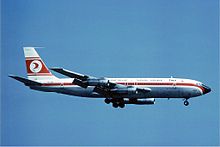
Picture - Turkish Airlines
Although certificated as Series 100s, 200s, 300s, etc. the different 707 variants are more commonly known as Series 120s, 220s, 320s, and so on where the "20" part of the designation is Boeing's "customer number" for its development aircraft.
367-80
The 367-80 (Dash-80) was the original prototype Boeing jet transport. Used to develop the KC-135 Stratotanker and the 707, it was fitted with four Pratt & Whitney JT3C engines, each producing 10,000 lbf (44.5 kN). First flight was 15 July 1954. Upon completion of initial test programs, it found use as a flying testbed for new technologies and for continuing improvements to the 707 series. Later fitted with Pratt & Whitney JT3D turbofans, it was retired to storage in Arizona. It is now preserved for public viewing at the Steven F. Udvar-Hazy Center of the Smithsonian National Air and Space Museum (NASM)'s annex near Washington Dulles International Airport.
707-120
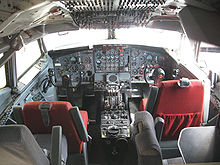
Picture - Boeing 707-123B cockpit
The 707-120 was the first production 707 variant. The variant featured a longer, wider fuselage and greater wingspan than the original Dash-80. A full set of rectangular cabin windows was included for the interior, which was capable of a seating 179 passengers. It was designed for transcontinental routes and often required a refuelling stop when used on the North Atlantic route. It was fitted with four Pratt and Whitney JT3C-6 turbojets, civilian versions of the military J57 model, which produced 12,500 lbf (55.6 kN) each, allowing a 247,000 lb (112,000 kg) takeoff gross weight. (Engines on American's 707s started at 13,000 lbf (58 kN) thrust, later increased to 13,500 lbf (60 kN) by increasing the turbine's allowed temperature.) First flight was on December 20, 1957. Major orders were the launch order for 20 707-121 aircraft by Pan American and an American Airlines order for 30 707-123 aircraft. The first revenue service of a 707 was on October 26, 1958. A total of 69 were built.
The 707-138 was based on the -120 but had a 10 ft (3.05 m) reduction to the rear fuselage and were capable of increased range. It was a variant for Qantas and included Boeing customer number of 38 for Qantas. A total of 13 -138s were built.
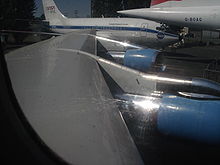
Picture - 707-120B (VC-137B) wing, showing the new inboard leading edge from the 720. Also, note the British Airways Concorde G-BOAG to the side.
The 707-120B was the first major upgrade to the design was a re-engining with JT3D-1 turbofans, which were quieter, more powerful, and more fuel-efficient, producing 17,000 lbf (75.6 kN) each, with the later JT3D-3 version giving 18,000 lbf (80 kN). The aircraft also received the wing modifications introduced on the 720. The tailplane was also enlarged on the -120B. A total of 72 of these were built, and many more were converted from 707-120 aircraft, including Qantas' aircraft, which became 707-138B aircraft upon conversion. The first flight of the -120B was on 22 June 1960.
707-220
The 707-220 was designed for hot and high operations with powerful Pratt & Whitney JT4A-3 turbojets, only five of these were produced, however only four were ultimately delivered with one being lost during a test flight. All were for Braniff International Airways and carried the model number 707-227. This version was made obsolete by the arrival of the turbofan-powered 707-120B.
707-320
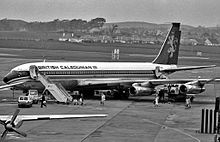
Picture - British Caledonian Boeing 707 shown at Glasgow Prestwick Airport, South Ayrshire, Scotland, c. 1972.
The 707-320 Intercontinental is a stretched version of the turbojet-powered 707-120, initially powered by JT4A-3 or JT4A-5 turbojets producing 15,800 lbf (70,000 N) each. The interior allowed for up to 189 passengers due to an 80-inch (2,000 mm) fuselage stretch (from 138 ft 10 in (42.32 m) to 145 ft 6 in), with extensions to both the tail and horizontal stabilizer extending the aircraft's length further. while a longer wing carried more fuel, increasing range by 1,600 miles (2,600 km) and allowing the aircraft to operate as true transoceanic aircraft. The wing modifications included outboard and inboard inserts, as well as a kink in the trailing edge to add area inboard. Takeoff weight was increased to 302,000 lb (137,000 kg) initially, and to 311,000 lb (141,000 kg) and perhaps further as higher-rated JT4A's became available. First flight was on January 11, 1958, and 69 turbojet 707-320s were produced. No -320 Intercontinental models were re-engined with fan engines in civil use, but around year 2000 the Israeli Air Force re-engined two ex-Sabena -320 based military tankers.
The 707-320B is a re-engined version undertaken in parallel with the -120B, using the same JT3D-3 turbofans and incorporating many of the same airframe upgrades as well. The wing was modified from the -320 by adding a second inboard kink, a dog-toothed leading edge, and triangular wingtips instead of the earlier blunt ones. These new wingtips increased overall wingspan by three feet. Takeoff gross weight was increased to 335,000 lb (152,000 kg). The 175 707-320B aircraft produced were all new-build, no original -320 models were converted to fan engines in civilian use.
The 707-320B Advanced is a slightly improved version of the -320B aircraft, adding three-section leading-edge flaps. These reduced takeoff and landing speeds, and also altered the lift distribution of the wing, allowing the ventral fin found on earlier 707s to be removed. The same wing was also used on the 707-320C.
The 707-320C has a convertible passenger-freight configuration which became the most widely produced variant of the 707. The 707-320C added a strengthened floor and a new cargo door to the -320B model. 335 of these variants were built, including a small number with uprated JT3D-7 engines and a takeoff gross weight of 336,000 lb (152,000 kg). Despite the convertible option, a number of these were delivered as pure freighters. One of the final orders was by the Iranian Government for 14 707-3J9C aircraft capable of VIP transportation, communication, and in-flight refuelling tasks.
The 707-420 is a version of the 707-320 originally produced at specific request for BOAC and powered by Rolls-Royce Conway 508 turbofans, producing 17,500 lbf (77.8 kN) each. Although BOAC were first to order the 707-320 delays in getting British certification meant that Lufthansa were the first to receive and operate the 707-320 in February 1960. A total of 37 were built to this configuration.
The 707-700 was a test aircraft used to study the feasibility of using CFM International's CFM56 powerplants on a 707 airframe and possibly retrofitting them to existing aircraft. After a testing in 1979, N707QT, the last commercial 707 airframe, was refitted to 707-320C configuration and delivered to the Moroccan Air Force as a tanker aircraft. (This purchase was considered a "civilian" order and not a military one.) Boeing abandoned the program, since they felt it would be a threat to the Boeing 757 program. The information gathered in the test led to the eventual retrofitting program of CFM56 engines to the USAF C-135/KC-135R models, and some military versions of the 707 also used the CFM56. Ironically the Douglas DC-8 "Super 70" series by Cammacorp did develop commercially, extending the life of DC-8 airframes in a stricter noise regulatory environment, so there are today more DC-8s in commercial service than there are 707s.
720
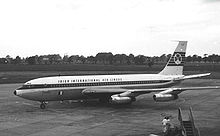
Picture - Boeing 720-048 of Aer Lingus-Irish International in 1965
The 720 was originally designated 707-020 but later changed for marketing reasons. It was a modification of the 707-120 designed for medium-range operation from shorter runways. It had four frames removed in front of the wing, and one aft, making it 8 feet 4 inches (2.54 m) shorter than the -120, and certified to a lower maximum takeoff weight. The wing modifications consisted of adding Krueger flaps outboard of the outboard engines to lower takeoff and landing speeds and thus shorten field length, and a thickened inboard section at the leading edge which had a slightly greater sweep. This modification increased the top speed over the -120, and was later available on the -120B and on -120s retrofitted to the B standard. This model had few sales but was still profitable due to the minimal R&D costs associated with modifying an existing type. At one point in the promotion stage to airlines it was known as the 717, although this was the Boeing model designation of the KC-135 and remained unused for a commercial airliner until it was applied to the MD-95 following Boeing's merger with McDonnell Douglas. The 720 was used before the Boeing 727 replaced it in the market. Its first flight was on November 23, 1959, and 64 of the original version were built.
The 720B was the turbofan-powered version of the 720, with JT3D-1-MC6 turbofans producing 17,000 lbf (75.6 kN) each. Takeoff gross weight was increased to 235,000 lb (107,000 kg). A total of 89 of these were built in addition to conversions of existing 720s. Boeing built a combined 154 of both 720 models from 1959 to 1967.
Military
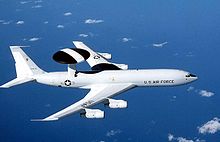
Picture - USAF E-3 Sentry in flight
The militaries of the United States and other countries have used the civilian 707 aircraft in a variety of roles, and under different designations. (Note the 707 and U.S. Air Force's KC-135 were developed in parallel from the Boeing 367-80 prototype.) The Canadian Forces also operated Boeing 707 with designation CC-137 Husky (707-347C) from 1972 to 1997.
The VC-137C variant of the Stratoliner was a special-purpose design meant to serve as Air Force One, the secure transport for the President of The United States of America. These models were in operational use from 1962 to 1990. The two aircraft remain on display: SAM 26000 is at the National Museum of the United States Air Force near Dayton, Ohio and SAM 27000 is at the Ronald Reagan Presidential Library in Simi Valley, California.
717
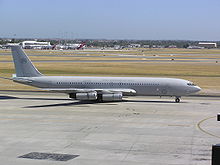
Picture - RAAF 707-368C at Perth International airport, Australia
Boeing 717 was the company designation for C-135 Stratolifter and KC-135 Stratotanker derivatives of the 367-80. The designation was later re-used in renaming the McDonnell Douglas MD-95 to Boeing 717 after the company was merged with Boeing.
Operators
In the 1980s, the USAF acquired around 250 used 707s to provide parts for the KC-135E Stratotanker program.
Although 707s are no longer employed by major airlines, as of March 2011, 43 aircraft were in use mainly with air cargo operators and air forces in Africa, Middle East and South America. Commercial operators of the Boeing 707 include Saha Airline, BETA Cargo, Enterprise World Airways, Libyan Airlines, Mid Express Tchad, Hewa Bora Airways and some other users with mostly stored aircraft. The Romanian Government uses a 707-320C as a Presidential Aircraft, being operated by Romavia. American actor John Travolta owns, and is qualified to fly as second in command, an ex-Qantas 707-138B, registration N707JT.
The list of customer codes used by Boeing to identify specific options and trim specified by customers was started with the 707, and has been maintained through all Boeing's models. Essentially the same system as used on the earlier Boeing 377, the code consisted of two digits affixed to the model number to identify the specific aircraft version. For example, Pan American Airlines was assigned code "21". Thus a 707-320B sold to Pan Am had the model number 707-321B. The number remained constant as further aircraft were purchased, thus when Pan American purchased the 747-100 it had the model number 747-121.
Deliveries
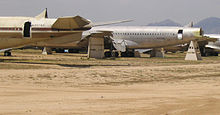
Picture - Boeing 707s at AMARG being used for salvage parts for the KC-135s.
Accidents and incidents
As of September 2010, the 707 has been in a total of 167 hull-loss occurrences with 2,739 fatalities.
Notable accidents
On October 19, 1959, a Boeing 707-227 crashed northeast of Arlington, Washington while on a training flight for Braniff International Airways. Four people were killed in the crash, and four survived.
On February 15, 1961, Sabena Flight 548, 707-320, crashed while on approach to Brussels Airport, Belgium. A total of 73 people were killed, including the United States Figure Skating team.
On March 1, 1962, American Airlines Flight 1, a 707-123B, crashed into Jamaica Bay after taking off from Idlewild Airport (now JFK Airport) while heading for Los Angeles International Airport. All 95 people on board died.
On May 22, 1962, Continental Airlines Flight 11, 707-124, was destroyed by a bomb while en route from Chicago, Illinois, to Kansas City, Missouri. Everyone on board was killed.
On June 3, 1962, Air France Flight 007, a 707-300, crashed while attempting to takeoff from Paris's Orly Airport. The crash killed 130 people aboard; two stewardesses survived. It was, at the time, the worst single-plane disaster.
On June 22, 1962, Air France Flight 117, a 707, crashed into a hill in Guadalupe while attempting to land at Pointe-x -Pitre, killing all 113 aboard.
On November 27, 1962: Varig flight 810, a Boeing 707-441 registration PP-VJB flying from Rio de Janeiro-Galex£o to Lima, after initiating an overshoot procedure at the suggestion of the control tower because it was too high, proceeded to start another approach when it crashed into La Cruz peak, 8 miles away from Lima Airport. Possibly there was a misinterpretation of navigation instruments. All 97 passengers and crew aboard died.
On February 12, 1963, Northwest Orient Airlines Flight 705, a 720B, suffered an in-flight break-up over the Florida Everglades approximately 12 minutes after leaving Miami, bound for Chicago. All 35 passengers and eight crew died. The cause of the crash was determined to be an unrecoverable loss of control due to severe turbulence.
On December 8, 1963, Pan Am Flight 214, a 707-121, crashed outside Elkton, Maryland during a severe electrical storm, with a loss of all 81 passengers and crew. The Boeing 707-121, registered as N709PA, was on the final leg of a San Juan - Baltimore - Philadelphia flight.
On May 20, 1965, Pakistan International Airlines Flight PK 705, a 720, crashed short of the runway at Cairo International Airport, killing 119 of the 125 people on board.
On September 17, 1965, Pan Am Flight 292, 707-120B, crashed into the side of a mountain in a storm on the island of Montserrat killing all 30 passengers and crew on board.
On January 24, 1966, Air India Flight 101, a 707-437, crashed into Glacier des Bossons on the SW face of Mont Blanc in the French Alps. All 106 passengers and 11 crew were killed.
On March 6, 1966, BOAC Flight 911, a 707-436 en route from Tokyo to Hong Kong, encountered clear air turbulence close to Mount Fuji; the sudden violent gusting caused the vertical stabilizer to detach from the aircraft, following which the aircraft entered an uncontrolled dive. The 707 progressively broke up as a result of aerodynamic over-stressing of the airframe, then struck the ground near the foot of the mountain. All those on board died.
On April 8, 1968, BOAC Flight 712, a 707-465, suffered engine failure on takeoff from London Heathrow Airport followed by an engine fire. The plane made an emergency landing back at the airport, but an explosion in the port wing caused the plane to catch fire. Four passengers and a flight attendant were killed and 122 escaped.
On April 20, 1968, South African Airways Flight 228 crashed shortly after takeoff from Windhoek, Namibia. The crew used a flap retraction sequence from the 707-B series on newly-delivered 707-C, which retracted the flaps in larger increments than desirable for that stage of the flight, leading to a loss of lift at 600 ft (180 m) above ground level. The inquiry blamed the crew for not observing their flight instruments when they had no visual reference.
On December, 12 1968, Pan Am Flight 217, a 707, en route to Caracas, Venezuela, crashed into the Caribbean Sea. All 51 passengers and crew on board died. City lights may have caused an optical illusion that affected the pilots.
On July 11, 1973, Varig Flight 820, a 707 registered PP-VJZ, on scheduled airline service from Galex£o Airport, Rio de Janeiro, Brazil to Orly Airport, Paris, France made an emergency landing in a field in the Orly community due to smoke in the cabin. The fire, smoke and crash resulted in 123 deaths, with 11 survivors (10 crew, one passenger).
On July 22, 1973, Pan Am Flight 816, a 707-321C, crashed shortly after takeoff at Papeete, Tahiti resulting in 78 deaths.
On November 3, 1973, Pan Am Flight 160, a 707-321C, crashed on approach to Boston-Logan. Smoke in the cockpit caused the pilots to lose control. Three people were killed in the hull-loss accident.
On April 22, 1974, Pan Am Flight 812, a 707-321B, crashed into a mountain while preparing for landing after a 4 hour 20 minutes flight from Hong Kong to Denpasar, Bali, Indonesia. All 107 people on board were killed.
On August 3, 1975, a chartered 707-321C crashed into a mountain while preparing to land at Agadir-Inezgane Airport. All 188 passengers and crew on board were killed. The 1975 Agadir Morocco Air Disaster has the highest death toll of any crash involving a 707.
On January 1, 1976, Middle East Airlines Flight 438, a 720B, was destroyed en-route from Beirut to Dubai by a bomb in the forward cargo hold. All 66 passengers and 15 crew were killed.
On April 20, 1978, Korean Air Lines Flight 902, a 707, was hit by a missile fired from a Soviet Sukhoi Su-15 interceptor after it had entered Soviet airspace. This caused a rapid decompression of the fuselage which killed two passengers. The 707 made an emergency landing on a frozen lake near Murmansk, USSR.
On January 30, 1979, a Varig cargo 707-323C, registration PP-VLU crashed while flying from Tokyo to Rio de Janeiro. Causes are unknown since the wreck was never found.
On October 13, 1983, a Bolivian cargo 707 crashed in Santa Cruz, Bolivia killing 91 (of whom 88 were killed on the ground when the aircraft crashed into a practice football game).
On January 3, 1987, Varig Flight 797, a 707-379C, crashed when making a return to Abidjan, Cx´te d'Ivoire after one of its engines failed. One person survived out of the 51 people onboard.
On November 29, 1987, Korean Air Flight 858, a 707-3B5C, exploded over the Andaman Sea, in the Indian Ocean in a terrorist attack with a bomb placed by North Korean agents. All 115 people on board died.
On February 8, 1989, Independent Air Flight 1851, a Boeing 707, crashed into a hill on approach to Santa Maria, Azores. All 144 people on board were killed. Wreckage remains at the site to this day.
On January 25, 1990, Avianca Flight 52, a 707-321B, crashed after running out of fuel in Long Island, New York. The 707 was delayed numerous times because of heavy fog in New York. A total of 73 people died.
On October 29, 1991, a 707 of the Royal Australian Air Force stalled and crashed into the sea off East Sale, Victoria. All five crew on board died.
On October 23, 1996, a 707 belonging to the Argentinian Air Force crashed on takeoff roll after failing to achieve required takeoff speed (V2) at Buenos Aires International Airport (EZE).
On September 21, 2000, the 707 belonging to the Government of Togo coming from Valencia Airport, Spain en route to Lomé-Tokoin Airport, Togo, experienced a cockpit fire approximately 200 km/125 miles from Niamey, Niger, and crash landed at Hamani Diori Airport, Niger. None of the 10 people aboard was killed but the aircraft was destroyed by subsequent fire.
On July 4, 2002, a 707-123B on a Gomair flight from N'Djamena Airport, Chad to Brazzaville-Maya Maya Airport, Rep. of Congo carrying a mixed load of cargo and passengers crashed. It experienced technical problems and diverted to Bangui, Central African Republic. On landing approach it descended too quickly and made ground-contact in a suburb. It subsequently bounced and broke up. Of the 30 people on board, 28 died in the accident.
On October 23, 2004, a BETA Cargo 707 on a Cargo flight from Manaus-Eduardo Gomes International Airport, Brazil to Sx£o Paulo-Guarulhos International Airport, Brazil aborted takeoff from Manaus due to a "loud noise". The aircraft afterwards started tilting to the right. It appeared the landing gear ruptured the right wing. The 37-year old aircraft (registration PP-BSE) was written-off.
On March 19, 2005, a Cargo Plus Aviation-owned 707-300 freighter on a wet-lease to Ethiopian Airlines crashed into Lake Victoria on approach to Runway 35 at Entebbe, Uganda on the lake's northern shore. The 31-year-old 707 freighter was on approach to Runway 35 during its second attempt to land. Its right wing clipped an outcrop on approach and it began to break up. The accident happened in heavy rain. The aircraft broke up, but the crew of five survived.
On 20 April 2005, Saha Air Lines Flight 171, a 707-3J9C, registration EP-SHE, flying from Kish Island, crashed on landing at Mehrabad Airport, Tehran following an unstabilized approach with a higher than recommended airspeed. Gear and/or a tyre failed after touchdown and the flight overran the far end of the runway. Of the 12 crew and 157 passengers, three passengers were killed, reportedly falling into the river after evacuation.
On 21 October 2009, Azza Transport Flight 2241, a 707-320, crashed shortly after takeoff from Sharjah International Airport, United Arab Emirates. The flight was carrying cargo only and all six crew members were killed.
Aircraft on display
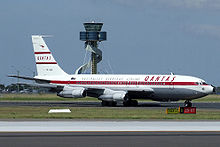
Picture - Ex-Qantas Boeing 707-138B VH-XBA undergoing taxi tests at Sydney International Airport prior to its delivery to the Qantas Founders Outback Museum
N70700 Model 367-80 (Prototype) previously at the Museum of Flight, Seattle, Washington; now at Steven F. Udvar-Hazy Center, Washington, D.C.
N714PA Model 707-321 (msn. 17592, no. 13) The nose section of this former Pan American aircraft is on display at the New England Air Museum at Bradley International Airport (KBDL), Windsor Locks, CT.
VH-XBA Model 707-138B (No. 29) one of the first 707s exported, and the first civilian jet registered in Australia (to airline Qantas in 1959), is on display at the Qantas Founders Outback Museum in Longreach, Queensland, Australia.
4X-BYD Model 707-131(F), (No. 34) ex-Israel Air Force is on display at the Israeli Air Force Museum near Hatzerim, Israel.
58-6971 Model 707-153B (VC-137B) (msn. 17926, no. 40) USAF VIP transport on display at Davis-Monthan Air Force Base, Tucson, AZ.
N3951A Model 707-123B (msn. 17647, no. 53) Nose section of former American Airlines aircraft (N7520A) on display at Auto Technik Museum Sinsheim, Germany.
00-SGA Model 707-329 (msn. 17623, no. 78) The forward fuselage section of Sabena's first Boeing 707 is preserved at the Royal Army & Military Museum in Brussels, Belgium.
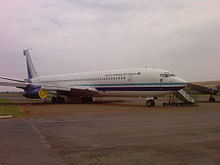
Picture - Retired South African Air Force Boeing 707-328C at the South African Air Force Museum, Pretoria
N99WT Model 707-321 (msn. 17606, no. 107) Former Pan American aircraft (N728PA) is used as the Club 707 restaurant near Manila, Philippines.Specifications
Sources:
Notable appearances in media
The 707 is mentioned in the songs "Boeing Boeing 707" by Roger Miller; "Jet Airliner" performed by the Steve Miller Band and written by Paul Pena; and "Early Morning Rain", written by Gordon Lightfoot and popularized by artists such as Elvis Presley, Bob Dylan, and Peter, Paul and Mary.
The aircraft has had major roles in the Airport and Airplane films, and has been alluded to in both television and theatrical movies.
Related development
Boeing 367-80
KC-135 Stratotanker
Boeing 727
Boeing 737
Comparable aircraft
de Havilland Comet
Convair 990
Douglas DC-8
Ilyushin Il-62
Shanghai Y-10
Tupolev Tu-114
Vickers VC10
Bibliography
Bowers, Peter M.. Boeing Aircraft since 1916. London: Putnam Aeronautical Books, 1989. ISBN 0-85177-804-6.
Bradley, Catherine. Boeing 707 Super Profile. Yeovil, Somerset UK: Haynes Publishing, 1983. ISBN 0-85429356-6.
Breffort, Dominique. Boeing 707, KC-135 and Civilian and Military Versions. Paris: Histoire & Collections. ISBN 978-2-35250-075-9.
Caidin, Martin. Boeing 707. New York: Bantam Books, 1959.
Cearley, George Walker. Boeing 707 & 720: A Pictorial History. Dallas, TX: G.W. Cearley Jr, 1993. No ISBN.
Francillon, René. Boeing 707: Pioneer Jetliner. Shrewsbury, Shropshire, UK: Motor Books International, 1999. ISBN 0-76030675-3.
Cook, William H. Road to the 707: The Inside Story of Designing the 707. Bellevue, WA: TYC Publishing Company, 1991. ISBN 0-96296-050-0.
Irving, Clive. Wide Body: The Making of the Boeing 747. Philadelphia: Coronet, 1994. ISBN 0-340-59983-9.
Lloyd, Alwyn T. Boeing 707 & AWACS in Detail and Scale. Falbrook, CA: Aero Publishers, 1987. ISBN 0-83068533-2.
Pither, Tony. The Boeing 707, 720 and C-135. Tonbridge, Kent, UK: Air-Britain (Historians) Ltd., 1998. ISBN 0-85130-236-X.
Price, Alfred. The Boeing 707. Leatherhead, Surrey, UK: Profile Publications, 1967.
Proctor, Jon. Boeing 720. Miami, FL: World Transport Press, 2001. ISBN 1-892-43703-1.
Schiff, Barry J. The Boeing 707. Blue Ridge Summit, PA: Tab Books, 1982, First edition 1967, . ISBN 0-81685-653-2.
Smith, Paul Raymond. Boeing 707 - Airline Markings No. 3. Shrewsbury, Shropshire, UK: Swan Hill Press, 1993. ISBN 1-85310087-0.
Stachiw, Anthony L. and Andrew Tattersall. Boeing CC137 (Boeing 347C) in Canadian Service. St. Catherines, ON: Vanwell Publishing Ltd., 2004. ISBN 1-5512-5079-9.
Whittle, John A. The Boeing 707 and 720. Tonbridge, Kent: Air Britain (Historians), 1972. ISBN 0-8513-0025-1.
Wilson, Stewart. Airliners of the World. Fyshwick, ACT, Australia: Aerospace Publications Pty Ltd., 1999. ISBN 1-875671-44-7.
Wilson, Stewart. Boeing 707, Douglas DC-8, and Vickers VC-10. Fyshwick, Australia, ACT: Aerospace Publications Pty Ltd., 1998. ISBN 1-875671-36-6.
Winchester, Jim. Boeing 707. Shrewsbury, Shropshire, UK: Airlife, 2002. ISBN 1-84037311-3.
Boeing 707 Pictures
More aircraft.
Source: WikiPedia